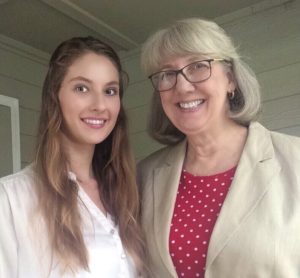The Genetic Puzzle of HHT

I never made it to my youngest daughter’s first birthday party in 1993. Due to intense pain in my back, I had to go to the local emergency room. I had been quite healthy until then. Because I was over 40, a routine chest X-ray was ordered with other diagnostics. They thought I might have a kidney stone. The major news followed – there was a large, benign mass in my lower right lung. Thus began my journey with HHT, Hereditary Hemorrhagic Telangiectasia.
The pulmonary arteriovenous malformation (PAVM) in my right lung was causing a 50 percent shunt, which meant my blood was getting less oxygen. My first lung intervention was needed. I had the embolization procedure, placement of many coils at this site, to close off the menacing tangle. I imagine my pregnancy, with the surge of hormones and normal body stress, had exacerbated and enlarged the malformation. In later years, this same PAVM would cause a life threatening event.
As time passed and I learned more about this rare disease, the puzzle pieces began to fit together. Things had happened previously with no explanation at the time. I had experienced a healthy, non-eventful pregnancy previously, yet my youngest daughter was born one month premature with extensive bacterial pneumonia. I did not have this. She was rushed, quiet and limp, to the intensive neonatal unit where she spent her first week hooked up to multiple monitoring wires, with antibiotics being pumped into her. She is 24 now and healthy, except she has been clinically diagnosed with HHT, too. She will be evaluated every three years at an HHT Center.
Since childhood, through “the change” in my life, I had experienced mild nosebleeds everyday and often multiple times each day. I had not questioned this too much, nor had any doctors! My dad had daily nosebleeds, in fact, his were stronger than mine.
Looking further, his mom had died suddenly, in her early 70s, of a massive stroke. My dad’s older brother had nosebleeds. And one of my uncle’s three children died of a stroke in her mid-70s, after lingering many years with its aftermath. On my paternal side, the anecdotal evidence was mounting. My dad died at 86 years old, having never been identified with HHT. These were the puzzle pieces of my heritage. They weren’t much.
When I tried to discuss my HHT diagnosis, my entire family acted disinterested. Were they in denial? Both parents, brother, sister-in-law and extended family members chose not to engage in learning about HHT. I was on my own.
Before this life changing diagnosis, in 1986, my dentist had found a “golf ball-sized” vascular tumor under my tongue. I had that surgically closed off. Was this another piece of the puzzle?
I was genetically tested in an attempt to find which gene mutation was causing my HHT. Unfortunately, the results didn’t help my family. With testing, I learned that 15 percent of those clinically diagnosed cannot be identified with the known gene mutations. This was my group. I hold out hope for a future test as research expands. This way my children and their offspring can someday learn their HHT genetic footprint.
My older daughter has suffered from migraine headaches for nearly 10 years. She is 28 and has clinically tested negative for HHT. I have encouraged her to get clinically evaluated again before she decides to have children, as I would encourage any woman who could have HHT, because the complications that can arise are varied and could be serious. Close monitoring during this time is important. I was fortunate. I was unaware. I was at the commencement of my HHT journey.
